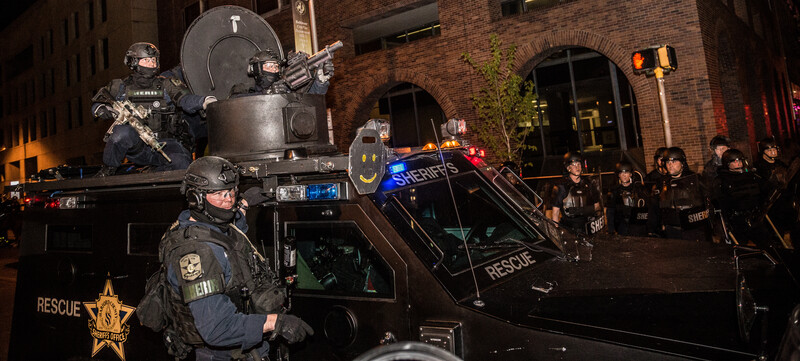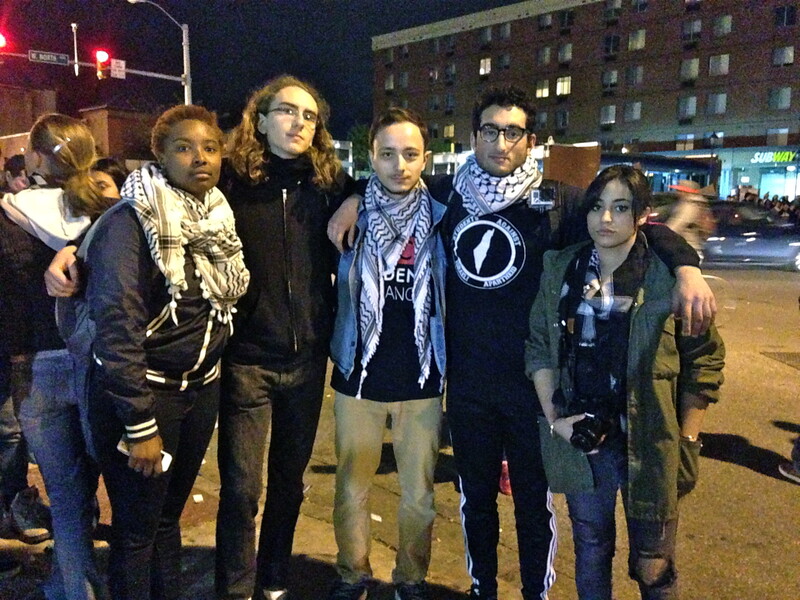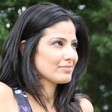Rights and Accountability 7 May 2015

Paramilitary police forces face off against peaceful protesters outside Baltimore City Hall after 10 pm curfew on Friday, 1 May. (Bryan MacCormack/Left in Focus)
For the second time in less than a year, an American city was transformed into a hypermilitarized police state to subdue growing resistance to anti-Black police violence.
Eight months ago, paramilitary forces barreled down the streets of Ferguson, Missouri, following the gruesome police killing of unarmed Black teenager Michael Brown.
Last week, martial law was imposed on the people of Baltimore, Maryland, in yet another crackdown aimed at crushing the Black Lives Matter uprising, galvanized this time by the police murder of Freddie Gray, a 25-year-old Black man whose spinal cord was severed while in police custody.
It was an occupation in the truest sense of the term. However, for Baltimore’s poor Black neighborhoods, it was a hypermilitarized version of the lower intensity occupation they are subjected to on a regular basis.
Protests demanding justice for Gray had been largely peaceful, until heavy-handed police tactics against Baltimore high school students on 27 April incited a riot.
Some young people responded by throwing bottles and rocks at police, prompting comparisons to Palestine, where children often toss stones at Israeli occupation forces as a means of resistance and self-defense.
Windows of police cruisers were smashed, stores were looted and a CVS store was set ablaze, throwing white America into a panicked frenzy that seemed to prioritize broken windows over broken spines, as one activist put it.
Martial law
Within hours of the riots, Baltimore city officials declared a state of emergency and instituted a 10pm curfew.
Practically overnight, Baltimore morphed into a heavily militarized police state with machine-like efficiency, demonstrating America’s frightening capacity to successfully implement martial law in a major US city in a matter of hours.
By Tuesday, 3,000 National Guard troops were deployed to Baltimore.

An armored police vehicle passes by the burned down a CVS store on the intersection of North and Pennsylvania avenues in Baltimore on 1 May. (Bryan MacCormack/Left in Focus)
With assault rifles in hand, bored US soldiers in official military combat attire roamed the streets of downtown Baltimore, patrolling the National Aquarium, as well as the outlets of Forever 21, Cheesecake Factory and Barnes & Noble that dot the trendy and polished Inner Harbor.
Serious overkill at the #Baltimore harbor. The aquarium is safe! pic.twitter.com/6VlClpWsx9
— Rania Khalek (@RaniaKhalek) April 30, 2015
The soldiers were flanked by police from a collection of law enforcement agencies from Maryland and across state lines, all working in concert with Baltimore police to crush the nascent uprising that erupted in the city’s long neglected poor Black neighborhoods. For these communities, martial law presented nothing more than an added layer to the ferocious police violence and intolerable economic deprivation that inform their daily lives.
Breaking curfew
On Friday, 1 May, around 80 protesters held their ground in the courtyard in front of City Hall. They were in high spirits and determined to break the 10pm curfew following news that six Baltimore police officers were charged in the killing of Freddie Gray.

Protesters huddle in the courtyard outside Baltimore City Hall on 1 May 2015, preparing to break the 10 pm curfew.
The Electronic IntifadaThe courtyard had become an unofficial media headquarters since the state of emergency began, saturated with TV news vans, cable news tents and lighting crews. The area also served as a command center for the National Guard and law enforcement.
As the curfew went into effect, a line of around a hundred riot police filed into the quad opposite the protesters, who had thinned out from a couple hundred to a few dozen. The mood was tense, but calm.

Riot police face off against protesters trying to break the curfew outiside Baltimore City Hall on 1 May. (Bryan MacCormack/Left in Focus)
Minutes later, hidden units of riot police thundered into the crowd, charging at frightened protesters who soon learned there was nowhere to run. Protesters were woefully outnumbered and surrounded, with all possible escape routes cut off by either riot squads, officers on horseback, armored vehicles with rooftop snipers or National Guard troops, reinforced by a police helicopter circling overhead.
Police officers dressed like storm troopers attacked one protester after the next completely unprovoked. I watched as police all around me tackled civilians, slamming them into the ground face first, piling on top of them and blindly swinging their batons. It was a police riot.
Police rushed protesters and are violently arresting ppl pic.twitter.com/q9KvmI21fV
— Rania Khalek (@RaniaKhalek) May 2, 2015
Meanwhile, police closed in on the media, jostling members of the press and repeatedly threatening them to get back.
It’s riot police versus the media. All protesters have been arrested or dispersed. #Baltimore pic.twitter.com/TFQsIMOgKG
— Rania Khalek (@RaniaKhalek) May 2, 2015
Mass arrests
Among those arrested that night was 32-year-old Chicago-based activist Danielle Villarreal, who was knocked to the ground by officers while quietly looking to see which of her comrades had been grabbed.
Her friend, Jackie Spreadbury, 26, instinctively reached for Villareal’s arm to protect her from police and was instantly thrown against a van and tossed to the ground, her cheek pressed up against the curb.
“They hit me with their batons on the back of the calf below the knee as I was already down on the ground,” Spreadbury told me, recollecting her arrest. “I didn’t realize at the time that I was getting hit. I was just looking at Danielle to see if she was okay.”
“A bunch of cops were yelling different things at me. And then they started yelling at me for not listening to all the different things they were demanding,” Spreadbury recalled.
“I’ve been to lots of demonstrations over the years and I’ve never seen this sort of pre-emptive oppression — outside of NATO in Chicago — where they lunged at us and chased us down without warning, and just pre-emptively attacked people,” said Villarreal, referring to the virtual police state during the NATO summit in Chicago in 2012 that saw protesters corralled, abused and arrested.
“If you want to see who wants a riot, look at who’s dressed for it,” added Villarreal, noting that police were the ones wearing body armor and carrying billy clubs.
During their 22 hour stay in jail, the women met countless Baltimore residents who were swept up by police for breaking curfew while going about their daily lives. “They were put in a cell with us — women, mothers daughters — they got picked up because of this police state. There was a 51–year-old woman who was arrested on her way from work at 4:45am during curfew,” said Spreadbury.
At least 486 people have been arrested in Baltimore since 23 April, a fifth of whom were held for 48 hours without explanation and released without charge.
Others were given astronomically high bails.
Allen Bullock, 18, turned himself in at the behest of his parents after a photo of him smashing a police windshield with a traffic cone was plastered in news reports across the country. Bullock is currently being held on a half a million dollar bail that his family can’t possibly afford. In stark contrast, the officers who severed Freddie Gray’s spine received bails no greater than $350,000.
Palestine contingent lends support
Building on the deepening bond between the Palestinian and Black liberation struggles, Palestinian civil society organizations issued a declaration of support for those struggling against racial injustice in Baltimore.
“We send our condolences to the family of Freddie Gray and all those murdered in police custody,” says the statement. “We stand in solidarity with those whose homes have been foreclosed, with those who live under the constant watch of surveillance cameras and under the constant threat of being stopped, harassed, arrested and assaulted by a militarized police force in their own streets. Your struggle for justice, equality and freedom is our struggle.”
A contingent of Palestine solidarity activists affiliated with Students for Justice with Palestine (SJP) at American University and Students Against Israeli Apartheid (SAIA) at George Mason University turned those words into action.

Palestine solidarity activists from Washington, DC, supporting protesters in Baltimore.
The Electronic IntifadaWearing their kuffiyehs — Palestinian checkered scarves — to remain easily visible to one another amid the likely chaos, the group shuffled back and forth between Washington, DC and Baltimore to lend their support as legal observers and medics.
“Oftentimes we struggle with wanting to participate because we don’t know if it’s our place and we don’t want to be co-opting,” said Ntebo Maya Mokuena, a 19-year-old member of SJP at AU. “But I think it’s important for people in DC to show solidarity in Baltimore because we’re so close.”
Mokuena gravitated toward Palestine solidarity work due to her father’s activism against apartheid in South Africa. “I saw the connections between his experiences in South Africa and what happens in Palestine. I thought it was really important to carry on the family legacy,” she told The Electronic Intifada.
“From Palestine to Baltimore, there are parallels with militarization of police and the tactics they use to take over space in other people’s land. They’re occupying people’s neighborhoods where they live. It’s like the second wave for Baltimore because it’s already economically occupied,” said Mokuena.
The group managed to avoid arrest during Friday night’s melee, though some told The Electronic Intifada that they were more frightened of police in Baltimore than Israeli forces at protests they had attended in Palestine.
“Even though I’ve been to protests in Palestine, I saw more physical abuse in Baltimore,” said Tareq Radi, a Palestinian American organizer and founding member of SAIA. Still, what he witnessed in Baltimore reminded him of Israeli crowd control in Palestine. “I went to the ‘day of rage’ protests in the Negev [Naqab] and I saw people getting slammed on the ground, hogtied, police grabbing their arms and legs and throwing them in the paddy wagon — the exact same imagery as Baltimore.”
“If Baltimore was a Middle Eastern country, we would be calling it a dictatorship,” Radi added.
Echoes of Israeli tactics in Baltimore
The similarities in suppression tactics employed by Baltimore and Israeli security forces are no coincidence.
Under the cover of counterterrorism training, nearly every major police agency in the United States has traveled to Israel for lessons in occupation enforcement, including many of the agencies active in Baltimore last week.
In 2002, Baltimore city police officers went to Israel on a junket organized by the neoconservative Jewish Institute for National Security Affairs (JINSA), where they studied Israeli occupation tactics used against Palestinians, including “crowd control, and coordination with the media,” according to a JINSA press release. “Participants resolved to begin the process of sharing ‘lessons learned’ in Israel with their law enforcement colleagues in the United States,” boasted JINSA.
Baltimore city police returned to Israel for more occupation training in a 2009 trip arranged by the American Jewish Committee’s Project Interchange.
On a 2007 training session in Israel, Baltimore County police reportedly “received valued lessons from Israeli officials … about gathering human and electronic intelligence” that can “apply to investigations into organized crime and gangs.”
The Montgomery County Police Department, which sent dozens of police officers to assist in the Baltimore crackdown, has attended several training sessions in Israel, including one in 2010 and another in 2012, both hosted by Project Interchange.
New Jersey State Police, which donated around 150 of its officers to Baltimore’s police state, learned lessons in occupation enforcement on trips to Israel arranged by the Anti-Defamation League in 2011 and 2013, and JINSA in 2004.
Pennsylvania State Police, which contributed 300 state troopers to Baltimore, studied counterterrorism in Israel in 2004.
While there is a wealth of scholarship on police militarization in the US, there has been little to no examination of the ways Israel’s security apparatus facilitates it. Instead, the issue is virtually ignored or flat out denied, despite the troubling implications of emulating an apartheid regime actively engaged in ethnic cleansing and war crimes.
Armed with cameras
There is something eerily consistent about occupation, whether in the ghettos of Palestine or the United States, including one of the most widely used means of resistance to it.
“A camera is the most trusted witness and the best protection tool,” Issa Amro, the founder and director of Youth Against Settlements, told me last year after his organization faced violent retaliation for recording Israeli soldiers pointing assault rifles at Palestinian teens in a video that went viral.
Kevin Moore, who filmed the video of Freddie Gray’s brutal arrest, sees the camera in a similar light.
“The most powerful weapon that we have against the police right now is a camcorder or any type of record that you can get against them performing those police brutal events,” argued Moore after his video of Gray went viral. After speaking out about Gray’s killing, Moore complained that police were intimidating him. He was later arrested with two activists from Copwatch, the police accountability organization he is a member of and released two hours later without charge.
Ramsey Orta, the man who filmed the chokehold killing of Eric Garner by NYPD officers in Staten Island last year, met an even worse fate. He was arrested along with his mother, brother and wife in what he contends is a campaign of vengeful harassment by the NYPD.
Meanwhile, not one of the officers who killed Garner on video will face charges; Video evidence of deadly police violence rarely results in accountability.
Under such intolerable conditions, where even video evidence of their murders isn’t enough to hold their killers accountable, it is no wonder that the oppressed are fighting back, from Baltimore to Ferguson to Palestine.
Tags
- Black Lives Matter
- Baltimore
- Ferguson
- Michael Brown
- Freddie Gray
- SJP
- Students Against Israeli Apartheid
- Students for Justice in Palestine
- JINSA
- Project Interchange
- National Guard
- Chicago
- Danielle Villarreal
- Jackie Spreadbury
- NATO
- Allen Bullock
- American University
- George Mason University
- Washington
- Ntebo Maya Mokuena
- Tareq Radi
- Negev (Naqab)
- ethnic cleansing
- American Jewish Committee
- Anti-Defamation League
- Issa Amro
- Youth Against Settlements
- Kevin Moore
- Copwatch
- Ramsey Orta
- Eric Garner
- apartheid
- South Africa
- war crimes
- Staten Island
- NYPD






Comments
It is incumbent upon
Permalink maggie replied on
It is incumbent upon President Obama to end the police training in Israel. Israel is a war criminal in the eyes of the world and it is damaging to our good name and our democracy for the United States to be in concert with Israel in such brutality against citizens.
Damaging to our good name
Permalink Bill Michtom replied on
Damaging to the US's good name? Really?
In the Middle East especially, the US has been viewed very negatively:
from 2010: http://www.salon.com/2010/08/0...
2011: http://www.washingtonpost.com/...
2012: http://pewglobal.org/files/201... and search for chapter titled Relationship With the United States and Israel
2013: http://www.theguardian.com/com...
2014: http://www.pewglobal.org/2014/...
Additionally, US policy helps Israel be the US outpost in the ME since Israel's founding.
more palestinian solidarity with baltimore
Permalink Hatem Abudayyeh replied on
thanks for the article, Rania. we think your readers will also be interested in this statement from an U.S. based Palestinian org: http://uspcn.org/2015/04/30/us...
No mention yet on this site...
Permalink Jim replied on
...of the Baltimore protests being linked in the media to those in Israel related to the killing of an Israeli Ethiopian soldier by police -- I can't say I'm surprised. It was humorous in a way to see American anti-police brutality protests, which EI stretches to connect with the Palestinian cause, co-opted by the other side.
Shin Bet and Mossad
Permalink Bill Michtom replied on
While there is no question that US police and security folks are going to Israel and are being trained in various contexts, there is no evidence presented here that these two agencies are involved. "Pants on Fire" is BS, but, with the evidence at hand, "untrue", is, indeed, the case.